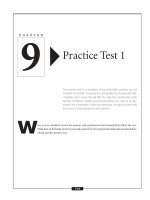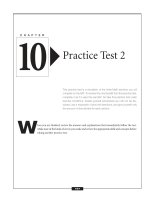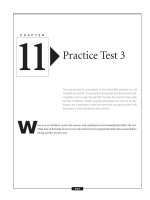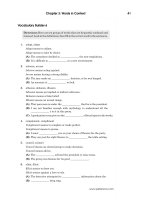SAT math essentials part 6 pptx
Bạn đang xem bản rút gọn của tài liệu. Xem và tải ngay bản đầy đủ của tài liệu tại đây (431.82 KB, 20 trang )
C H A P T E R
7
Geometry
Review
This chapter reviews key skills and concepts of geometry that you need
to know for the SAT. Throughout the chapter are sample questions in
the style of SAT questions. Each sample SAT question is followed by
an explanation of the correct answer.
Vocabular y
It is essential in geometry to recognize and understand the terminology used. Before you take the SAT, be sure
you know and understand each geometry term in the following list.
acute angle
an angle that measures less than 90°
acute triangle
a triangle with every angle that measures less than 90°
adjacent angles
two angles that have the same vertex, share one side, and do not overlap
angle
two rays connected by a vertex
arc
a curved section of a circle
area
the number of square units inside a shape
bisect
divide into two equal parts
central angle
an angle formed by an arc in a circle
95
– GEOMETRY REVIEW –
chord
a line segment that goes through a circle, with its endpoints on the circle
circumference
the distance around a circle
complementary angles
two angles whose sum is 90°
congruent
identical in shape and size; the geometric symbol for congruent to is Х
coordinate plane
a grid divided into four quadrants by both a horizontal x-axis and a vertical y-axis
coordinate points
points located on a coordinate plane
diagonal
a line segment between two non-adjacent vertices of a polygon
diameter
a chord that passes through the center of a circle—the longest line you can draw
in a circle. The term is used not only for this line segment, but also for its length.
equiangular polygon
a polygon with all angles of equal measure
equidistant
the same distance
equilateral triangle
a triangle with three equal sides and three equal angles
exterior angle
an angle on the outer sides of two lines cut by a transversal; or, an angle outside
a triangle
hypotenuse
the longest leg of a right triangle. The hypotenuse is always opposite the right
angle in a right triangle.
interior angle
an angle on the inner sides of two lines cut by a transversal
isosceles triangle
a triangle with two equal sides
line
a straight path that continues infinitely in two directions. The
geometric notation for a line through points A and B is ෆB.
Aෆ
line segment
the part of a line between (and including) two points. The geometric notation for
the line segment joining points A and B is ෆB. The notation AB is used both to
Aෆ
ෆෆ
refer to the segment itself and to its length.
major arc
an arc greater than or equal to 180°
midpoint
the point at the exact middle of a line segment
minor arc
an arc less than or equal to 180°
obtuse angle
an angle that measures greater than 90°
obtuse triangle
a triangle with an angle that measures greater than 90°
ordered pair
a location of a point on the coordinate plane in the form of (x,y). The x represents
the location of the point on the horizontal x-axis, and the y represents the
location of the point on the vertical y-axis.
96
– GEOMETRY REVIEW –
origin
coordinate point (0,0): the point on a coordinate plane at which
the x-axis and y-axis intersect
parallel lines
two lines in a plane that do not intersect. Parallel lines are marked by a symbol ||.
parallelogram
a quadrilateral with two pairs of parallel sides
perimeter
the distance around a figure
perpendicular lines
lines that intersect to form right angles
polygon
a closed figure with three or more sides
Pythagorean theorem
the formula a2 + b2 = c2, where a and b represent the lengths of the
legs and c represents the length of the hypotenuse of a right triangle
Pythagorean triple
a set of three whole numbers that satisfies the Pythagorean theorem,
a2 + b2 = c2, such as 3:4:5 and 5:12:13
quadrilateral
a four-sided polygon
radius
a line segment inside a circle with one point on the radius and the other point at
the center on the circle. The radius is half the diameter. This term can also be
used to refer to the length of such a line segment. The plural of radius is radii.
ray
half of a line. A ray has one endpoint and continues infinitely in one direction.
The geometric notation for a ray is with endpoint A and passing through point B
is .
AB
rectangle
a parallelogram with four right angles
regular polygon
a polygon with all equal sides
rhombus
a parallelogram with four equal sides
right angle
an angle that measures exactly 90°
right triangle
a triangle with an angle that measures exactly 90°
scalene triangle
a triangle with no equal sides
sector
a slice of a circle formed by two radii and an arc
similar polygons
two or more polygons with equal corresponding angles and corresponding sides
in proportion
slope
the steepness of a line, as determined by
vertical change
ᎏᎏᎏ
horizontal change
y Ϫy
2
1
, or ᎏᎏ, on a
x2 Ϫ x1
coordinate plane where (x1, y1) and (x2, y2) are two points on that line
solid
a three-dimensional figure
square
a parallelogram with four equal sides and four right angles
supplementary angles
two angles whose sum is 180°
97
– GEOMETRY REVIEW –
surface area
the sum of the areas of the faces of a solid
tangent
a line that touches a curve (such as a circle) at a single point without cutting
across the curve. A tangent line that touches a circle at point P is perpendicular to the circle’s radius drawn to point P
transversal
a line that intersects two or more lines
vertex
a point at which two lines, rays, or line segments connect
vertical angles
two opposite congruent angles formed by intersecting lines
volume
the number of cubic units inside a three-dimensional figure
Formulas
The formulas below for area and volume will be provided to you on the SAT. You do not need to memorize them
(although it wouldn’t hurt!). Regardless, be sure you understand them thoroughly.
Rectangle
Circle
Triangle
r
w
h
l
A = lw
C = 2πr
A = πr2
b
A = 1 bh
2
Rectangle
Solid
Cylinder
r
h
h
w
l
V = πr2h
C
A
r
l
=
=
=
=
Circumference
Area
Radius
Length
V = lwh
w
h
V
b
=
=
=
=
Width
Height
Volume
Base
98
– GEOMETRY REVIEW –
Angles
ra
y
#1
An angle is formed by two rays and an endpoint or line segments that meet at a point, called the vertex.
ray #2
vertex
Naming Angles
There are three ways to name an angle.
B
1
D
2
A
C
1. An angle can be named by the vertex when no other angles share the same vertex: ∠A.
2. An angle can be represented by a number or variable written across from the vertex: ∠1 and ∠2.
3. When more than one angle has the same vertex, three letters are used, with the vertex always being the
middle letter: ∠1 can be written as ∠BAD or ∠DAB, and ∠2 can be written as ∠DAC or ∠CAD.
The Measure of an Angle
The notation m∠A is used when referring to the measure of an angle (in this case, angle A). For example, if ∠D
measures 100°, then m∠D ϭ 100°.
99
– GEOMETRY REVIEW –
Classifying Angles
Angles are classified into four categories: acute, right, obtuse, and straight.
■
An acute angle measures less than 90°.
Acute
Angle
■
A right angle measures exactly 90°. A right angle is symbolized by a square at the vertex.
Right
Angle
■
An obtuse angle measures more than 90° but less then 180°.
Obtuse Angle
■
A straight angle measures exactly 180°. A straight angle forms a line.
Straight Angle
100
– GEOMETRY REVIEW –
Practice Question
A
B
Which of the following must be true about the sum of m∠A and m∠B?
a. It is equal to 180°.
b. It is less than 180°.
c. It is greater than 180°.
d. It is equal to 360°.
e. It is greater than 360°.
Answer
c. Both ∠A and ∠B are obtuse, so they are both greater than 90°. Therefore, if 90° ϩ 90° ϭ 180°, then the
sum of m∠A and m∠B must be greater than 180°.
Complementary Angles
Two angles are complementary if the sum of their measures is 90°.
1
2
Complementary
Angles
m∠1 + m∠2 = 90°
Supplementary Angles
Two angles are supplementary if the sum of their measures is 180°.
Supplementary
Angles
1
2
m∠1 + m∠2 = 180
101
– GEOMETRY REVIEW –
Adjacent angles have the same vertex, share one side, and do not overlap.
1
2
Adjacent
Angles
∠1 and ∠2 are adjacent
The sum of all adjacent angles around the same vertex is equal to 360°.
1
4
2
m∠1 + m∠2 + m∠3 + m∠4 = 360°
3
Practice Question
38˚
y˚
Which of the following must be the value of y?
a. 38
b. 52
c. 90
d. 142
e. 180
102
– GEOMETRY REVIEW –
Answer
b. The figure shows two complementary angles, which means the sum of the angles equals 90°. If one of
the angles is 38°, then the other angle is (90° Ϫ 38°). Therefore, y° ϭ 90° Ϫ 38° ϭ 52°, so y ϭ 52.
Angles of Intersecting Lines
When two lines intersect, vertical angles are formed. In the figure below, ∠1 and ∠3 are vertical angles and ∠2
and ∠4 are vertical angles.
1
4
2
3
Vertical angles have equal measures:
■
■
m∠1 ϭ m∠3
m∠2 ϭ m∠4
Vertical angles are supplementary to adjacent angles. The sum of a vertical angle and its adjacent angle is 180°:
■
■
■
■
m∠1 ϩ m∠2 ϭ 180°
m∠2 ϩ m∠3 ϭ 180°
m∠3 ϩ m∠4 ϭ 180°
m∠1 ϩ m∠4 ϭ 180°
Practice Question
6a˚
3a˚
b˚
What is the value of b in the figure above?
a. 20
b. 30
c. 45
d. 60
e. 120
103
– GEOMETRY REVIEW –
Answer
d. The drawing shows angles formed by intersecting lines. The laws of intersecting lines tell us that 3a° ϭ
b° because they are the measures of opposite angles. We also know that 3a° ϩ 6a° ϭ 180° because 3a°
and 6a° are measures of supplementary angles. Therefore, we can solve for a:
3a ϩ 6a ϭ 180
9a ϭ 180
a ϭ 20
Because 3a° ϭ b°, we can solve for b by substituting 20 for a:
3a ϭ b
3(20) ϭ b
60 ϭ b
Bisecting Angles and Line Segments
A line or segment bisects a line segment when it divides the second segment into two equal parts.
A
C
B
The dotted line bisects segment AB at point C, so AC ϭ CB.
ෆෆ
ෆෆ ෆෆ
A line bisects an angle when it divides the angle into two equal smaller angles.
C
45
45
A
According to the figure, ray bisects ∠A because it divides the right angle into two 45° angles.
AC
104
– GEOMETRY REVIEW –
Angles Formed with Parallel Lines
Vertical angles are the opposite angles formed by the intersection of any two lines. In the figure below, ∠1 and
∠3 are vertical angles because they are opposite each other. ∠2 and ∠4 are also vertical angles.
1
4
2
3
A special case of vertical angles occurs when a transversal line intersects two parallel lines.
transversal
1
4
5
8
2
3
6
7
The following rules are true when a transversal line intersects two parallel lines.
There are four sets of vertical angles:
∠1 and ∠3
∠2 and ∠4
∠5 and ∠7
∠6 and ∠8
■ Four of these vertical angles are obtuse:
∠1, ∠3, ∠5, and ∠7
■ Four of these vertical angles are acute:
∠2, ∠4, ∠6, and ∠8
■ The obtuse angles are equal:
∠1 ϭ ∠3 ϭ ∠5 ϭ ∠7
■ The acute angles are equal:
∠2 ϭ ∠4 ϭ ∠6 ϭ ∠8
■ In this situation, any acute angle added to any obtuse angle is supplementary.
m∠1 ϩ m∠2 ϭ 180°
m∠2 ϩ m∠3 ϭ 180°
m∠3 ϩ m∠4 ϭ 180°
m∠1 ϩ m∠4 ϭ 180°
m∠5 ϩ m∠6 ϭ 180°
m∠6 ϩ m∠7 ϭ 180°
m∠7 ϩ m∠8 ϭ 180°
m∠5 ϩ m∠8 ϭ 180°
■
105
– GEOMETRY REVIEW –
You can use these rules of vertical angles to solve problems.
Example
In the figure below, if c || d, what is the value of x?
a
b
x°
c
(x – 30)°
d
Because c || d, you know that the sum of an acute angle and an obtuse angle formed by an intersecting line (line
a) is equal to 180°. ∠x is obtuse and ∠(x Ϫ 30) is acute, so you can set up the equation x ϩ (x Ϫ 30) ϭ 180.
Now solve for x:
x ϩ (x Ϫ 30) ϭ 180
2x Ϫ 30 ϭ 180
2x Ϫ 30 ϩ 30 ϭ 180 ϩ 30
2x ϭ 210
x ϭ 105
Therefore, m∠x ϭ 105°. The acute angle is equal to 180 Ϫ 105 ϭ 75°.
Practice Question
x
a˚ 110˚
y
b˚
z
c˚ 80˚
p
d˚
e˚
q
If p || q, which the following is equal to 80?
a. a
b. b
c. c
d. d
e. e
Answer
e. Because p || q, the angle with measure 80° and the angle with measure e° are corresponding angles, so
they are equivalent. Therefore e° ϭ 80°, and e ϭ 80.
106
– GEOMETRY REVIEW –
Interior and Exterior Angles
Exterior angles are the angles on the outer sides of two lines intersected by a transversal. Interior angles are the
angles on the inner sides of two lines intersected by a transversal.
transversal
1
4
5
8
2
3
6
7
In the figure above:
∠1, ∠2, ∠7, and ∠8 are exterior angles.
∠3, ∠4, ∠5, and ∠6 are interior angles.
Triangles
Angles of a Triangle
The measures of the three angles in a triangle always add up to 180°.
1
2
3
m∠1 + m∠2 + m∠3 = 180°
Exterior Angles of a Triangle
Triangles have three exterior angles. ∠a, ∠b, and ∠c are the exterior angles of the triangle below.
a
1
b 2
■
3
c
An exterior angle and interior angle that share the same vertex are supplementary:
107
– GEOMETRY REVIEW –
m∠1ϩ m∠a ϭ 180°
m∠2ϩ m∠b ϭ 180°
m∠3ϩ m∠c ϭ 180°
■ An exterior angle is equal to the sum of the non-adjacent interior angles:
m∠a ϭ m∠2 ϩ m∠3
m∠b ϭ m∠1 ϩ m∠3
m∠c ϭ m∠1 ϩ m∠2
The sum of the exterior angles of any triangle is 360°.
Practice Question
a°
95°
b°
50°
c°
Based on the figure, which of the following must be true?
I. a < b
II. c ϭ 135°
III. b < c
a. I only
b. III only
c. I and III only
d. II and III only
e. I, II, and III
Answer
c. To solve, you must determine the value of the third angle of the triangle and the values of a, b, and c.
The third angle of the triangle ϭ 180° Ϫ 95° Ϫ 50° ϭ 35° (because the sum of the measures of the
angles of a triangle are 180°).
a ϭ 180 Ϫ 95 ϭ 85 (because ∠a and the angle that measures 95° are supplementary).
b ϭ 180 Ϫ 50 ϭ 130 (because ∠b and the angle that measures 50° are supplementary).
c ϭ 180 Ϫ 35 ϭ 145 (because ∠c and the angle that measures 35° are supplementary).
Now we can evaluate the three statements:
I: a < b is TRUE because a ϭ 85 and b ϭ 130.
II: c ϭ 135° is FALSE because c ϭ 145°.
III: b < c is TRUE because b ϭ 130 and c ϭ 145.
Therefore, only I and III are true.
108
– GEOMETRY REVIEW –
Types of Triangles
You can classify triangles into three categories based on the number of equal sides.
■
Scalene Triangle: no equal sides
Scalene
■
Isosceles Triangle: two equal sides
Isosceles
■
Equilateral Triangle: all equal sides
Equilateral
You also can classify triangles into three categories based on the measure of the greatest angle:
■
Acute Triangle: greatest angle is acute
70°
Acute
50°
60°
109
– GEOMETRY REVIEW –
■
Right Triangle: greatest angle is 90°
Right
■
Obtuse Triangle: greatest angle is obtuse
Obtuse
130°
Angle-Side Relationships
Understanding the angle-side relationships in isosceles, equilateral, and right triangles is essential in solving questions on the SAT.
■
In isosceles triangles, equal angles are opposite equal sides.
2
2
m∠a = m∠b
■
In equilateral triangles, all sides are equal and all angles are 60°.
60º
s
s
60º
60º
s
110
– GEOMETRY REVIEW –
■
In right triangles, the side opposite the right angle is called the hypotenuse.
e
us
n
te
po
Hy
Practice Question
100°
6
40°
6
40°
Which of the following best describes the triangle above?
a. scalene and obtuse
b. scalene and acute
c. isosceles and right
d. isosceles and obtuse
e. isosceles and acute
Answer
d. The triangle has an angle greater than 90°, which makes it obtuse. Also, the triangle has two equal sides,
which makes it isosceles.
Pythagorean Theorem
The Pythagorean theorem is an important tool for working with right triangles. It states:
a2 ϩ b2 ϭ c2, where a and b represent the lengths of the legs and c represents the length of the hypotenuse of a
right triangle.
Therefore, if you know the lengths of two sides of a right triangle, you can use the Pythagorean theorem to
determine the length of the third side.
111
– GEOMETRY REVIEW –
Example
4
c
3
a2 ϩ b2 ϭ c2
32 ϩ 42ϭ c2
9 ϩ 16 ϭ c2
25 ϭ c2
͙25 ϭ ͙c2
ෆ
ෆ
5ϭc
Example
a
12
6
a 2 ϩ b 2 ϭ c2
a2 ϩ 62 ϭ 122
a2 ϩ 36 ϭ 144
a2 ϩ 36 Ϫ 36 ϭ 144 Ϫ 36
a2 ϭ 108
ෆ
ෆ
͙a2 ϭ ͙108
a ϭ ͙108
ෆ
112
– GEOMETRY REVIEW –
Practice Question
7
4
What is the length of the hypotenuse in the triangle above?
ෆ
a. ͙11
b. 8
ෆ
c. ͙65
d. 11
e. 65
Answer
c. Use the Pythagorean theorem: a2 ϩ b2 ϭ c2, where a ϭ 7 and b ϭ 4.
a2 ϩ b 2 ϭ c2
72 ϩ 42 ϭ c2
49 ϩ 16 ϭ c2
65 ϭ c2
͙65 ϭ ͙c2
ෆ
ෆ
͙65 ϭ c
ෆ
Pythagorean Triples
A Pythagorean triple is a set of three positive integers that satisfies the Pythagorean theorem, a2 ϩ b2 ϭ c2.
Example
The set 3:4:5 is a Pythagorean triple because:
32 ϩ 42 ϭ 52
9 ϩ 16 ϭ 25
25 ϭ 25
Multiples of Pythagorean triples are also Pythagorean triples.
Example
Because set 3:4:5 is a Pythagorean triple, 6:8:10 is also a Pythagorean triple:
62 ϩ 82 ϭ 102
36 ϩ 64 ϭ 100
100 ϭ 100
113
– GEOMETRY REVIEW –
Pythagorean triples are important because they help you identify right triangles and identify the lengths of
the sides of right triangles.
Example
What is the measure of ∠a in the triangle below?
3
5
a
4
Because this triangle shows a Pythagorean triple (3:4:5), you know it is a right triangle. Therefore, ∠a must
measure 90°.
Example
A right triangle has a leg of 8 and a hypotenuse of 10. What is the length of the other leg?
8
10
?
Because this triangle is a right triangle, you know its measurements obey the Pythagorean theorem. You could
plug 8 and 10 into the formula and solve for the missing leg, but you don’t have to. The triangle shows two parts
of a Pythagorean triple (?:8:10), so you know that the missing leg must complete the triple. Therefore, the second leg has a length of 6.
It is useful to memorize a few of the smallest Pythagorean triples:
3:4:5
32 + 42 = 52
6:8:10
62 + 82 = 102
5:12:13
52 + 122 = 132
7:24:25
72 + 242 = 252
8:15:17
82 + 152 = 172
114









